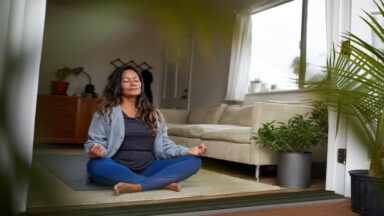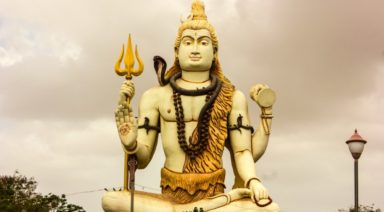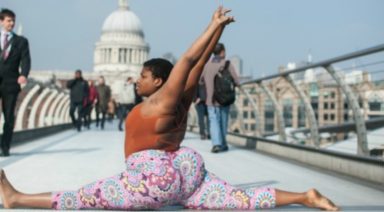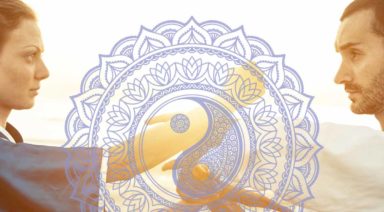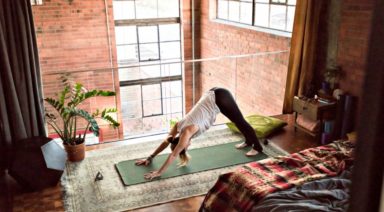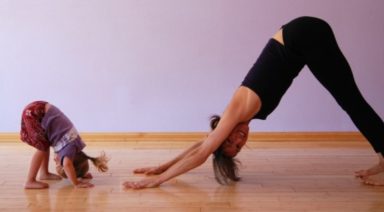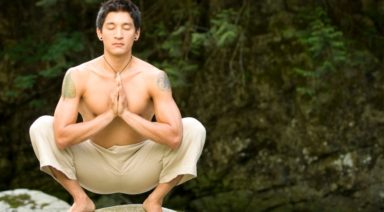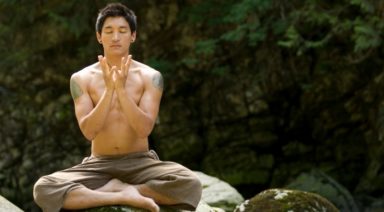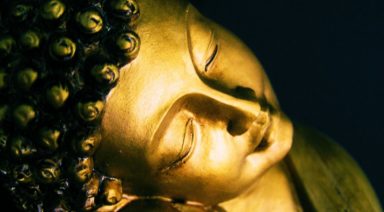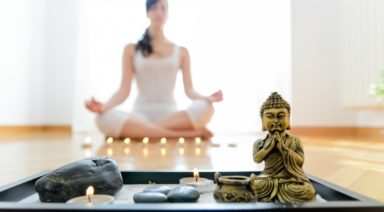5 Survival Tips for Teaching Your First Yoga Class
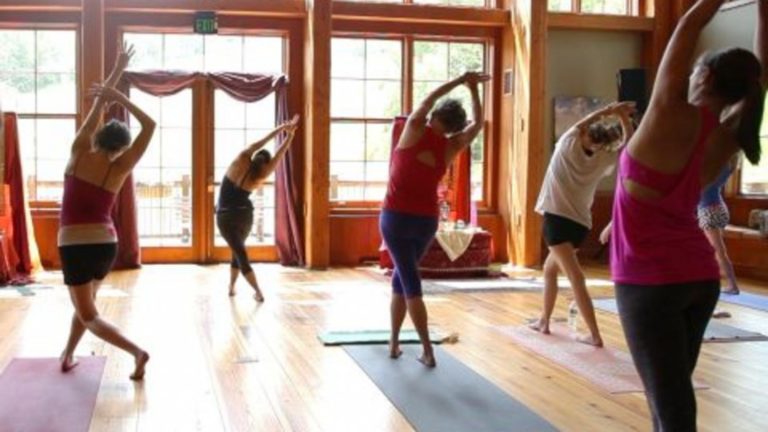
So, you’ve finished your initial 200 hour yoga teacher training. Congratulations! You’ve got the certification in your hand and found somewhere to teach. Now you have to get up in front of a group and lead a yoga practice. Terrifying, right? I thought so too, but I promise it’s not anywhere near as scary as you think it is. Take a deep breath, make a plan, and enjoy yourself.
- Breathe. Just breathe.
Yoga students can smell your fear. It’s normal to be nervous, but don’t let it overcome you. I spend a lot of time reminding my students to breathe and then often forget myself! Public speaking is not something that comes naturally to everyone, but it is a skill that everybody can develop through practice. I needed to practice with close friends again and again before I felt like I was starting to get a handle on my nerves. The more you practice, the more comfortable you will become.
- Never apologise.
There’s a good chance you might slip up – get your left foot confused with your right, miss a pose in your carefully designed class plan, forget what that thing connecting your head to your shoulders is called, but don’t panic. Smile at your students and laugh. Never apologise. Of course it’s instinctual, to say you’re sorry, but try to get out of the habit when you’re leading a class. I have, on occasion, seen some of the most efficient yoga teachers I know lose their way. Everybody makes mistakes.The majority of the time, your students won’t even notice.
- Keep it simple.
You’re new. No one expects you to be teaching complicated classes. I know it’s tempting to be creative, but don’t get carried away. The more intricate your flow, the more opportunity there is for you to make mistakes, forget what you’re doing, mix up your left and your right, or just simply have a nervous breakdown mid-class. The first time I constructed a class, I tried running through it myself and quickly realised that I was pushing myself too hard, let alone any prospective students.
- Don’t be too proud to have a plan.
Even the best yoga teachers go into classes with a plan. Experienced teachers will have sequences that they know like the back of their hand and so formulating a class is fairly easy, but as you start out, you will need to put a lot of thought into the structure of your class. I like to have a brief plan written out in a small notebook to keep beside my mat at the front of the class, just in case I get lost and need a quick reminder of what comes next.
- Teach what you practice.
The most important piece of advice I learned during my teacher training was the mantra, “Teach what you practice.” Everyone has their limitations, even yoga teachers! A pivotal moment for me in training was when our anatomy teacher demonstrated that, due to the length of his torso, he was unable to do Parivritta Parsvakonasana (revolved side angle). It doesn’t matter how flexible or strong you are, there are just some poses that you may never achieve due to your body type. If you don’t practice Headstand, don’t teach it. If you are not flexible enough to do the splits, don’t teach it. If you don’t have the hip rotation to do Lotus, don’t teach it. It’s not just about demonstrating a pose; it’s also a matter of knowing the asana well enough in your own body to be able to ensure the safety of your students.
Select the Best Yoga Teacher Training for You
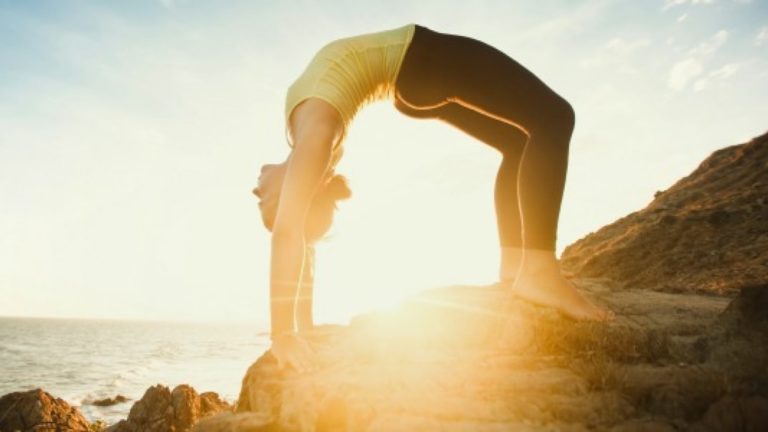
When the spark of teacher training first ignites in your heart, a few things start to happen. You start to approach your yoga practice in a different, albeit intimate way, considering what it would be like to teach what you are experiencing. You develop an even deeper respect for your yoga instructors and begin to pick up on the subtle details of their creative offerings. But most of all you start to see “YTT” everywhere you look. It’s like that magic thing that happens when you buy a car; you start to see the same model on the road and in parking lots. Once you open up to the possibility of becoming a teacher, you become aware of all the incredible ways you could go about doing it. And if you dared to Google “yoga teacher training,” then you probably learned about programs and styles that you had never even heard of before. This can be overwhelming at first–it can feel like you require training to choose the right training. Then again, you are committing to a tremendous investment both financially and energetically; it’s only natural that you want to do your homework.
Before you even start the selection process, I encourage you to try this journaling exercise to gain clarity around why you want to attend a teacher training in the first place.
- Do you want to teach yoga or are you more interested in deepening your personal practice?
- What is your most natural mode of learning (visual, kinesthetic, auditory) and what is your ideal learning environment?
- What is it that sparked your interest? Was it the practice, was it a particular teacher? What was the impetus for the shift from practicing on your mat to seeking a program for deeper study?
- In your yoga vision, are you teaching full-time, part-time, or as a hobby? Does this teaching supplement your current work/projects in any way?
- What is the state of your current life work balance?
Having answered the questions above, you are now clear in your teaching intention and can use it as an anchor during the process of choosing a program. Stay open as you start searching because you may not even know of something you want in a yoga school until you find it! When you are ready to start looking, here are the top 5 things to consider when selecting yoga teacher training.
- Teacher Trainer(s).
Everyone and their uncle seem to be offering a teacher training program these days, so what exactly should you look for? It is important to understand whether you want to train with someone that you already have a relationship with or if you are comfortable selecting a teacher based on their core values alone. You’ll discover that many programs are offered by a single lead trainer whereas other programs have guest teachers or teaching teams. Is this relevant to how you want to learn? Is it important for you to train with a man or a woman? If so, why?
Know your teacher’s teachers! In our modern world, hatha yoga is practiced in a myriad of styles and forms, make sure you want to practice (and teach) the style of yoga that is being offered by the trainers you choose. This may seem obvious, but you don’t want to go to an Ashtanga teacher training if it is a Kundalini practice that lights you up! Try to understand who your teacher has practiced with and learned from. What is their yoga lineage and how does this breathe life into your teaching intention?
Finally, it is not absolutely necessary that you love everything about your teacher, but it is important that their teaching inspires you and they are capable of providing you the depth of study that you’re after. Some of the best teachers aren’t always well liked because they challenge us to be the very best versions of ourselves–that is what makes them great teachers.
Once you have narrowed your search to a handful of instructors, start connecting! Reach out to the teaching staff for more information, ask to connect with recent graduates in your area, attend an information session, and read as many reviews and testimonials as you can find!
- Content and Curriculum
This is where your reasons for wanting to pursue deeper studies in yoga come into play. You must decide what it is that you want to learn without really knowing what it is that you don’t know! It’s the ultimate yoga conundrum. Chances are, if you have an interest in teacher training, you’ve at least practiced some asana. Maybe you’ve read about the yoga sutras and other texts. Perhaps you’ve dabbled in Ayurveda or heard teachers talk about the heart chakra. Or, maybe you only show up to class for savasana. In any case, it helps to understand the core areas of study available. For simplicity, they are presented here based on the definition of yoga practice in the sutras: tapas svadhyaya ishvara pranidhana kriya yogah.
Tapas (heating, churning, purifying). This means actually moving your body and studying how/why it works. Areas of study include:
- asana, pranayama and meditation techniques
- physical practice
- physical anatomy (bones, muscles)
- energetic anatomy (chakras, subtle body)
- Ayurveda
Svadhyaya (self-study). In the context of yoga teacher training, this is learning what it means to be a teacher and how to apply what you know. Areas of study include:
- how to teach/student teaching
- hands-on assisting
- observation of classes
- communication & student psychology
- creating healthy boundaries
Ishvara Pranidhana (surrender to the absolute). This is a recognition that yoga (and teaching yoga) is not about you. It is a part of something much, much greater and goes beyond the purely physical domain. Areas of study include:
- history & philosophy
- study of source texts
- ethics & yogic lifestyle
- karma yoga
In addition to the content that is available, it is important to understand how it will be transmitted. Do you want to learn a set sequence that you can begin teaching immediately? Do you want a program that supports an equal focus among the above categories or do you want more emphasis in a particular area? Do you need to learn how to be a teacher or is this something that already comes naturally to you from your background?
Once you understand the range of yoga “majors” that are available, you can select the most appropriate “degree plan” for you. Review the course outline for any programs that capture your interest and make sure you understand the topics that will be offered and the depth of study in each.
- Timing, Duration, and Location
The timing of the program has to be convenient so that you can be your most receptive self. Still, there’s no absolutely perfect time to take the leap. There will always be a million reasons to say no, but it only takes one really good reason to say yes! Furthermore, there are benefits to both destination and residential formats. Does it work for your life rhythm to disconnect and retreat for 3-4 full weeks or do you want to maintain a regular schedule and create space for training on the evenings and weekends? In a destination training, you get to unplug and fully immerse yourself in the learning. The continuity of the teaching often allows you to go deeper and experience the transformation of fire. However, a residential program allows you space to integrate the learning between sessions and share everything you’re exploring in the moment with your family and friends. The transformation happens more slowly, like water eroding the earth, but it can be equally profound.
Once you decide how teacher training fits into your life, you can start to explore different locations. This might mean looking into different studios in your city or different countries in the world. The most important consideration for the location of your program is how it will support your physical, mental and spiritual growth throughout the process. For example, do feel most responsive outdoors or do you prefer a classroom environment? Do you want to practice in a hot studio or does your body feel better without the added element of heat?
My best advice is to find a program that has the best alignment to your yogic journey and let the timing, duration and location details be secondary. With a strong desire to learn and a clear vision, you can make almost anything work once your heart is fully on-board.
- Class Size
This one goes without saying but is worth mentioning all the same. It is no secret that the smaller the class size, the more intimate instruction you might be able to receive from the instructor. However, part of the appeal of teacher training is that you are entering a kula (community) of like-minded humans that you will undoubtedly learn from. With a larger class size, you open yourself up to communion with a wider range of practitioners and skill sets. It is up to you to decide what class size serves your personal study in the most meaningful way.
- Network/Postgraduate Support
It is easy to get so focused on the incredible growth that happens during teacher training that you forget to consider what comes after you graduate. Again, come back to your teaching intention. What do you want to come away with from your program? Do you want to begin teaching immediately? If so, how does each unique school make this a reality for you? Perhaps you see this as the first step in a life-long study and are interested in continuous support when the course comes to an end. What does the postgraduate communication and development look like? This is another great opportunity to reach out to graduates of various programs and see where people have taken their yoga degrees. At the very least, you will be inspired by the incredible creativity and passion that you find along the way.
Finally, searching for a yoga teacher training is not an opportunity to bargain shop. Yoga is not something you can learn all at once. Instead, it continues to unfold as you study, practice and teach. Stay committed to your core values and make a heart-centered decision based on where you want to devote your passion and energy.







